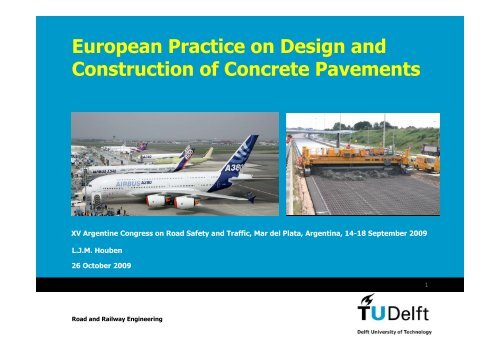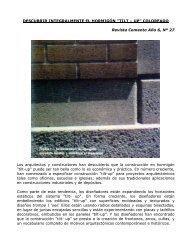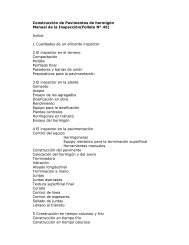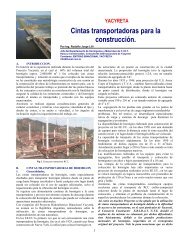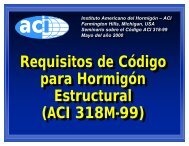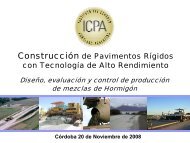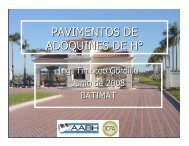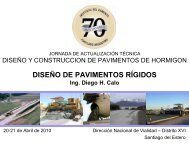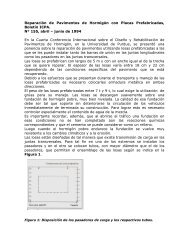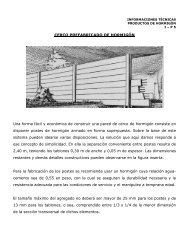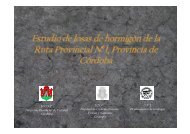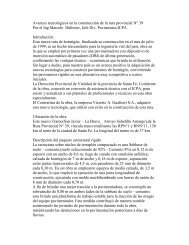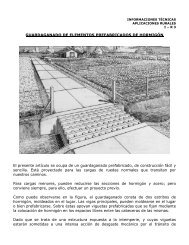Dutch design method - ICPA
Dutch design method - ICPA
Dutch design method - ICPA
- No tags were found...
Create successful ePaper yourself
Turn your PDF publications into a flip-book with our unique Google optimized e-Paper software.
Europe44 countries26 October 2009 3
European Union EU27 countriesarea ≈ 4,000,000 sq kmpopulation ≈ 500,000,000Argentinaarea ≈ 2,800,000 sq kmpopulation ≈ 41,000,00026 October 2009 4
Overview aspects of European <strong>design</strong><strong>method</strong>sGeneralDesign <strong>method</strong>sTraffic loadingConcrete gradeSubstructureConcrete thicknessEuropean standards26 October 2009 5
Overview aspects of European <strong>design</strong><strong>method</strong>sGeneralFEHRL Working Group ELLPAGState-of-the-art reports (<strong>design</strong>, construction,maintenance, rehabilitation, economics)Long-life concrete pavements: well <strong>design</strong>edand constructed, ‘indefinite’ structuralpavement life, surface maintenance26 October 2009 6
Overview aspects of European <strong>design</strong><strong>method</strong>s10 European countries in ELLPAG:Austria (A)the Netherlands (NL)Belgium (B)Poland (P)Czech Republic (CR) Spain (E)France (F)Switzerland* (S)Germany (G) United Kingdom (UK)* non-EU26 October 2009 7
Overview aspects of European <strong>design</strong><strong>method</strong>s2 types of concrete pavements in Europe:JPCP:• no reinforcement• contraction joints => slabs: ≈ square, ≤ 5 m• bars in joints, mostly sealedCRCP:• mid-depth shrinkage reinforcement =>pattern of transverse cracks• only longitudinal contraction joints• sometimes special wearing course (PAC)26 October 2009 8
Overview aspects of European <strong>design</strong><strong>method</strong>sShare of concrete pavements on main roadnetwork:• ≈ 35% in Austria, Belgium• ≈ 25% in Germany• < 10% in other countriesReasons: tradition, experience, subsoil,investment vs. life-cycle costs26 October 2009 9
Overview aspects of European <strong>design</strong><strong>method</strong>sDesign <strong>method</strong>sNo European <strong>design</strong> <strong>method</strong>Each country own <strong>design</strong> <strong>method</strong>Most countries: <strong>method</strong> mainly empirical(addressed later: German <strong>method</strong>)Exceptions: <strong>method</strong> mainly analytical in France,the Netherlands (addressed later: theNetherlands)26 October 2009 10
Overview aspects of European <strong>design</strong><strong>method</strong>sTraffic loadingParameters:• maximum axle load (105 – 130 (B,E,F) kN)• standard <strong>design</strong> axle load (80 (UK) – 130 (F) kN)• <strong>design</strong> period (20 – 40 years)• maximum cumulative traffic loading (ESALs)• axle load frequency distribution (NL)Warning: legal limits is not reality (overloading!)26 October 2009 11
Overview aspects of European <strong>design</strong><strong>method</strong>sPolandSpainConcrete gradeCountryAustriaBelgiumCzech RepublicFranceGermanyThe NetherlandsSwitzerlandUnited KingdomAge of testing(days)28902828282828282828compressive35 / 4062.525 / 35-30 / 3735 / 45--30-Concrete strength (MPa)flexural tensile indirect (splitting) tensile5.5---3.5 – 4.5--2.7----4 – 6-3.5 – 4.5-5.5-4.5 - 6-26 October 2009 12
Overview aspects of European <strong>design</strong><strong>method</strong>sSubstructureBase (+ sub-base) + subgradeSubgrade: A: Ev2 ≥ 35 MPaG: Ev2 ≥ 45 MPaS: Ev2 = 22.5 – 45 MPaF: Edyn ≥ 120 MPa (main roads)E: cement-stabilised (main roads)26 October 2009 13
Overview aspects of European <strong>design</strong><strong>method</strong>sSub-base:NL: ≥ 0.5 m sandUK: granular, CBR ≥ 15% ifsubgrade CBR < 5%Base: UK: cement-boundF: cement-bound (main roads)B: 200 mm lean concrete (main roads)200 mm granular (other roads)26 October 2009 14
Overview aspects of European <strong>design</strong><strong>method</strong>sBase: E: 150 mm lean concrete (main roads)200 – 400 mm granular (other roads)A,G,P,S,NL: cement-bound or granular,effect on concrete thicknessB,F,NL: asphalt layer (50 – 90 mm) below CRCP26 October 2009 15
Overview aspects of European <strong>design</strong><strong>method</strong>sConcrete thicknessJPCP and CRCP <strong>design</strong> example for:• 5000 cv per day on <strong>design</strong> traffic lane• concrete: compressive strength 32 MPaflexural tensile strength 4 MPaindirect tensile strength 2.7 MPa• base modulus 100 MPa (confusion!)26 October 2009 16
Overview aspects of European <strong>design</strong><strong>method</strong>sJPCPCRCP: B,F: 200 mmE,NL,UK: 250 mm26 October 2009 17
Overview aspects of European <strong>design</strong><strong>method</strong>sEuropean standards (EN = European Norms)Materials for concrete pavementsFunctional requirements and test <strong>method</strong>s forconcrete pavementsDowel and tie barsJoint fillers and sealantsThe 33 standards are listed in Appendix 1 ofpaper26 October 2009 18
German <strong>design</strong> <strong>method</strong> (empirical)Large scale experience over more than 100yearsIn ’70 and ’80 much analytical work done byprof. Eisenmann (TU Munich)Structural <strong>design</strong> guidelines regularly revisedRStO 01 contains standard JPCP structures,dependent on traffic loading and type of base26 October 2009 19
German <strong>design</strong> <strong>method</strong> (empirical)RStO 0126 October 2009 20
German <strong>design</strong> <strong>method</strong> (empirical)Type of roadTotal no. ofequivalent100 kN (10ton)standardaxle loadson <strong>design</strong>traffic lanein <strong>design</strong>period26 October 2009 21
German <strong>design</strong> <strong>method</strong> (empirical)Type of base:1.1, 1.2, 1.3 =cementboundbase(high to lowquality)2 = asphaltbase3 = granularbase26 October 2009 22
German <strong>design</strong> <strong>method</strong> (empirical)Total thicknessof non frostsusceptiblematerials(dependent onlocation)ConcretethicknessBase thicknessThickness base+ concreteThickness nonfrost susceptiblesub-base26 October 2009 23
German <strong>design</strong> <strong>method</strong> (empirical)Minimum Ev2at top ofsub-baseMinimum Ev2at top ofsubgrade26 October 2009 24
German <strong>design</strong> <strong>method</strong> (empirical)Ev2 from static plate load test with stiffcircular steel plate:Ev21.5 pa=ywhere:Ev2 = deformation modulus (MPa)P = applied maximum stress (MPa)a = radius of circular plate (= 150 mm)y = measured rebound (elastic) deformation(mm) during unloading at 2 nd load cycle26 October 2009 25
German <strong>design</strong> <strong>method</strong> (empirical)Ev2 used for check on quality of construction!Slab width w ≈ traffic lane widthSlab length l ≤ 7.5 mSlab length l < 25 * slab thickness hRatio of slab length l and slab width w < 1.3(based on analyses Eisenmann, limitingtemperature gradient stresses)Practice: slab dimensions l*w ≈ 5*4 m26 October 2009 26
German <strong>design</strong> <strong>method</strong> (empirical)In transverse contraction joints: coated nonprofiledsteel dowel bars (diameter 25 mm,length 500 mm), mid-depth in concrete,spacing 250 mm (main roads)In longitudinal contraction joints: profiledsteel tie bars (diameter 20 mm, length 800mm), 3 per slab length, at 2/3 of concretedepth, central 1/3 part coated26 October 2009 27
<strong>Dutch</strong> <strong>design</strong> <strong>method</strong> (analytical)1 st version: 1982• Only JPCP• Wrong Westergaard-equation for traffic load stresses• Eisenmann-procedure for calculation of temperature gradient stresses• Axle load frequency distribution• Temperature gradient 0.05 °C/mm together with 5% of traffic loads2 nd version: 1993• Only JPCP• Correct Westergaard-equation for traffic load stresses• Modified Eisenmann-procedure for calculation of temperature gradientstresses• Axle load frequency distribution• Temperature gradient frequency distribution26 October 2009 28
<strong>Dutch</strong> <strong>design</strong> <strong>method</strong> (analytical)3 rd version: 2005• JPCP and CRCP• Modified axle load frequency distributions and temperaturegradient frequency distribution, based on measurements in2000/2001Released as software package VENCON2.0 (in<strong>Dutch</strong>)26 October 2009 29
<strong>Dutch</strong> <strong>design</strong> <strong>method</strong> – Flow chart1. Traffic loadings:Axle loadsDirectional factorDesign traffic laneTraffic at joints2. Climate:Temperaturegradients3. Substructure:Modulus ofsubstructurereaction4. Concrete:StrengthparametersElastic modulus5. Traffic load stresses:Load transfer at jointsWestergaard equation6. Temperature gradientstresses:Eisenmann/<strong>Dutch</strong> <strong>method</strong>7. Thickness plain/reinforcedpavement:Miner fatigue analysis9. Reinforcement ofreinforced pavements:Shrinkage and temperatureTension bar modelCrack width criterion8. Additional checksplain pavements:Robustness (NEN 6720)Traffic-ability at opening10. Additional checksreinforced pavement:Robustness (NEN 6720)Traffic-ability at openingParameter studies26 October 2009 30
<strong>Dutch</strong> <strong>design</strong> <strong>method</strong> - Axle loadmeasurements (WIM)26 October 2009 31
<strong>Dutch</strong> <strong>design</strong> <strong>method</strong> - Some axle loadfrequency distributionsAxle loadgroup (kN)20-4040-6060-8080-100100-120120-140140-160160-180180-200200-220Average nr. of axlesAveragewheel load P(kN)152535455565758595105Overloaded axles (%)Axle load frequency distribution (%) for some type of roadsHeavily loaded motorway20.1630.5626.0612.546.512.711.000.310.120.033.5≈ 12Normally loadedprovincial road24.8432.4521.3611.126.482.700.830.190.030.003.5≈ 10Rural road49.3825.9713.668.052.180.380.380.000.000.003.1≈ 326 October 2009 32
<strong>Dutch</strong> <strong>design</strong> <strong>method</strong> - Tire typefrequency distributionsEquivalent radius of tire:a = b √(0.0028*P + 51) [mm]Type of tireSingle tireDual tireWide base tire(super single)Extra wide widebase tireParameter b9.212.48.79.1Frequency distribution (%)roads3938230public transportbus lanes50500026 October 2009 33
<strong>Dutch</strong> <strong>design</strong> <strong>method</strong> – Temperaturegradient frequency distributionTemperaturegradient class(ºC/mm)0.000 – 0.0050.005 – 0.0150.015 – 0.0250.025 – 0.0350.035 – 0.0450.045 – 0.0550.055 – 0.065Average temperaturegradient ΔT(ºC/mm)0.00250.010.020.030.040.050.06Frequencydistribution(%)59227.55.54.51.00.526 October 2009 34
<strong>Dutch</strong> <strong>design</strong> <strong>method</strong> - Modulus ofsubstructure reaction-4 C3 C5k= 2.7145.10 (C1 + C2.e + C4.e )where:C1 = 30 + 3360.koC2 = 0.3778 (hb –43.2)C3 = 0.5654 ln(ko) + 0.4139 ln(Eb)C4 = -283C5 = 0.5654 ln(ko)ko = modulus of subgrade/substructure reaction at top of underlyinglayer (N/mm³)hb = thickness of layer under consideration (mm)Eb = dynamic modulus of elasticity of layer under consideration (N/mm²)k = modulus of substructure reaction at top of layer underconsideration (N/mm³); k ≤ 0.16 N/mm³26 October 2009 35
<strong>Dutch</strong> <strong>design</strong> <strong>method</strong> - ConcreteMean flexural tensile strength, fbrm (in N/mm²)after 28 days for loadings of short duration:fbrm = 1.3 [(1600 – h)/1000)] [1.05 + 0.05 (f’ck + 8)]/1.2Young’s modulus of elasticity, Ec (in N/mm²):Ec = 22250 + 250 · f’ck with 15 ≤ f’ck ≤ 65where:f’ck = characteristic cube compressive strength (N/mm²)after 28 days for loading of short durationh = concrete thickness (mm)26 October 2009 36
<strong>Dutch</strong> <strong>design</strong> <strong>method</strong> -ConcreteProperties after 28 days for loadings of short durationPropertyCharacteristic cube compressivestrength, f’ck (N/mm²)Mean cube compressive strength,f’cm (N/mm²)Mean tensile strength, fbt (N/mm²)C28/35 (B35)35433.47Concrete gradeC35/45 (B45)45534.01Mean flexural tensile strength, fbrm(N/mm²): h = 180 mmh = 210 mmh = 240 mmh = 270 mmModulus of elasticity, Ec (N/mm²)4.924.824.714.6131,0005.695.575.455.3333,50026 October 2009 37
<strong>Dutch</strong> <strong>design</strong> <strong>method</strong> – Traffic load stressesEdge loading most critical:. centre of longitudinal edge/joint (temperature gradientstresses). wheel track at transversal joint (no. of load repetitions)‘New’ Westergaard equation for circular tire contact area:( υ )( υ)33 1+ Pcal⎧⎪⎛ Ech ⎞ 4 1−υa⎫⎪σ P = ln1.84 1.182 ⎨ ⎜4 ⎟ + − υ + + ( 1 + 2 υ)⎬π 3+ h ⎪⎩⎝100 k a ⎠ 3 2l ⎭⎪Due to load transfer W at joints/cracks:WPcal( 1 1/2 W /100)P ⎛ ⎞= − = ⎜1−⎟ P⎝ 200 ⎠Values of W given in paper26 October 2009 38
<strong>Dutch</strong> <strong>design</strong> <strong>method</strong> – Temperature gradientstressesAt edge due to positive temperature gradient Δt:Case 1:Δt = small: concrete slab fully supported:Case2:Δt = large:concrete slab only supported at edges:longitudinal edge:transverse edge:σT=h⋅ΔT2α E5 '2σ T= 1.8*10 − L / h5 '2σ T= 1.8*10 − W / hc' 2' 2L = L − C W = W − Cwith:33Smallest stress of cases 1 and 2C=4.5*khΔT26 October 2009 39
<strong>Dutch</strong> <strong>design</strong> <strong>method</strong> – Thickness jointedplain/continuously reinforced pavementThickness determined on basis of fatigue damage analysis12.903 (0.995 − σmax/ fbrm)ilog Ni= with 0.5 ≤σmax/ fbrm≤ 0.8331.000 − 0.7525 σ / fbrmminiNi = number of repetitions of wheel load Pi i.e. the traffic loadstress σPi until failure combined with a temperaturegradient stress σTiσmini = minimum flexural tensile stress (= σTi)σmaxi = maximum flexural tensile stress (= σPi + σTi)fbrm = mean flexural tensile strength (N/mm²)iDesign criterion: Palmgren-Miner fatigue damage rule: 126 October 2009 40∑inN =i
<strong>Dutch</strong> <strong>design</strong> <strong>method</strong> - Case StudyStructural <strong>design</strong> of plain concretepavementProvincial 2-lane road, 7.5 m wideLongitudinal joint, W = 70% (tie bars)26 October 2009 41
<strong>Dutch</strong> <strong>design</strong> <strong>method</strong> - Case StudyPlain concrete pavement structure:• slab width 3.75 m, length 4.5 m• doweled transverse joints: W = 80%• 250 mm cement-bound base, E = 6000MPa, Wfree edge = 35%• 500 mm sand sub-base, E = 100 MPa• subgrade E = 100 MPa k0 = 0.045N/mm3• k = 0.16 N/mm3 (maximum value)26 October 2009 42
<strong>Dutch</strong> <strong>design</strong> <strong>method</strong> - Case StudyDefault temperature gradient frequencydistributionTraffic loading:• heavy vehicles 300 days per year• heavy traffic equally divided over 2 lanes• traffic growth 3% per year• 3 axles per heavy vehicle• default frequency distribution of tire type• 50% of heavy vehicles in centre of wheel track,2% at free edge and 10% at longitudinal joint26 October 2009 43
<strong>Dutch</strong> <strong>design</strong> <strong>method</strong> - Case StudyVariables in calculation:• concrete grade: C28/35 or C35/45• axle load frequency distribution: heavy or normal• no. of heavy vehicles per day on traffic lane in 1 styear: 10, 100 or 1000• <strong>design</strong> life: 20, 30 or 40 yearsIn all cases: centre of free edge dominant for thickness<strong>design</strong>26 October 2009 44
<strong>Dutch</strong> <strong>design</strong> <strong>method</strong> - Case Studyplain concrete pavement, effects of concrete grade and axle loadfrequency distribution260concrete slab thickness (mm)25024023022021020020 25 30 35 40<strong>design</strong> life (years)C28/35, heavy, 100 C28/35, normal, 100 C35/45, heavy, 100 C35/45, normal, 10026 October 2009 45
<strong>Dutch</strong> <strong>design</strong> <strong>method</strong> - Case Studyplain concrete pavement, effects of concrete grade and number ofheavy trucks per day280concrete slab thickness (mm)27026025024023022021020020 25 30 35 40<strong>design</strong> life (years)C28/35, heavy, 10 C28/35, heavy, 100 C28/35, heavy, 1000C35/45, heavy, 10 C35/45, heavy, 100 C35/45, heavy, 100026 October 2009 46
<strong>Dutch</strong> <strong>design</strong> <strong>method</strong> - Case StudyConcrete grade:C28/35 instead of C35/45 requires 25 to 30 mmmore concreteAxle load frequency distribution:heavy distribution requires 10 mm extra concreteIntensity heavy traffic:10 times more traffic requires 10 to 15 mm moreconcreteDesign life:2 times longer life requires 5 to 10 mm more concrete26 October 2009 47
Modern construction techniquesDiscussed in paperNot presented26 October 2009 48
Rehabilitation Ring Road R1, Antwerp26 October 2009 49
Rehabilitation Ring Road R1, Antwerp26 October 2009 50
Rehabilitation Ring Road R1, Antwerp26 October 2009 51
Rehabilitation Ring Road R1, AntwerpR1 opened in 1969Length 14.2 km, incl. 690 m KennedyTunnel and 1700 m Viaduct Merksem6 radial motorways tying to R130 km access and exit ramps on interchangesAsphalt pavement structure26 October 2009 52
Rehabilitation Ring Road R1, AntwerpPartial rehabilitation in 1976 and 19772*4 through traffic lanes (2*3 in KennedyTunnel)Locally up to 7 lanes per directionAsphalt pavement structure26 October 2009 53
Rehabilitation Ring Road R1, AntwerpIn 2004:Up to 200,000 vehicles per day, incl.25% trucks (harbour, through traffic)Concrete pavementin Kennedy Tunnelseriously damaged26 October 2009 54
Rehabilitation Ring Road R1, AntwerpAsphalt pavementon main road R1seriously damaged(cracking, patching,ravelling)Surface run-offproblem26 October 2009 55
Rehabilitation Ring Road R1, AntwerpResearch into structural condition =>major rehabilitation for safe, modern andefficient road, service life ≥ 35 years, lowmaintenance26 October 2009 56
Rehabilitation Ring Road R1, AntwerpRehabilitation works:Eastern carriageway: June – November 2004Western carriageway: April – September 200526 October 2009 57
Rehabilitation Ring Road R1, AntwerpTraffic regulation during rehabilitation:• closure all entrances/exits of local roads• ≥ 2*2 lanes for through traffic oncarriageway not under construction• ≥ 1 lane for through traffic to/frominterchanges with radial motorways• very extensive communication to road users,also in neighbouring countriesResult: hardly any traffic jams26 October 2009 58
Rehabilitation Ring Road R1, AntwerpTemporarypremanufacturedbridges inparallelcity ringroad,to beused bylocaltraffic26 October 2009 59
Rehabilitation Ring Road R1, AntwerpChoice of type of pavement:• on ramps of interchanges: asphalt pavement• main Ring Road R1:- alternatives: asphalt pavement and CRCP- Life Cycle Cost analysis: NPV about equal- Multi Criteria Analysis: CRCP slightly better- choice: CRCP- exceptions: Kennedy Tunnel: JPCPViaduct Merksem: asphalt26 October 2009 60
Rehabilitation Ring Road R1, AntwerpRecycling of materials:Existing asphalt pavement recycled (largequantities, saving on raw materials, reductionconstruction traffic outside works site):• asphalt partly in new asphalt mixes andpartly in new cement-bound asphaltaggregate base• lean concrete base in new granular sub-base26 October 2009 61
Rehabilitation Ring Road R1, AntwerpStructural <strong>design</strong> CRCP:Design accordingto BelgianguidelinesAsphalt interlayerbetween CRCPand base26 October 2009 62
Rehabilitation Ring Road R1, AntwerpExposed aggregate concrete surfaceConcrete:• stone gradings 4/7, 7/14 and 14/20 mm;% 4/7 mm ≥ 20% of total granular mix% sand as low as possible• water/cement-ratio < 0.45• cement content > 400 kg/m³• air-entraining additive26 October 2009 63
Rehabilitation Ring Road R1, AntwerpTotal % reinforcement (l + t): 0.74%Longitudinal: steel bars BE 500 S, diameter 20mm, spacing 0.18 m, length 14 m, lap0.7 m, skewed splice patternTransverse: steel bars BE 500 S, diameter 12mm, spacing 0.7 m, angle 60°, supportedby chairs fixed in asphalt interlayerIn longitudinal construction joints: tie bars,diameter 16 mm, spacing 0.8 m26 October 2009 64
Rehabilitation Ring Road R1, AntwerpGeneral arrangement of reinforcing steel26 October 2009 65
Rehabilitation Ring Road R1, AntwerpTransverse + longitudinal reinforcement + laplongitudinal reinforcement bars26 October 2009 66
Rehabilitation Ring Road R1, AntwerpEnd of CRCP:End movements due to temperature changes:• restrain through expensive transverseanchoring lugs; applied for auxiliary trafficlanes (no movements of CRCP on main road)• accommodate in one or more expansionjoints with neoprene joint profile (bridges);applied on main road between CRCP andadjacent asphalt pavement26 October 2009 67
Rehabilitation Ring Road R1, AntwerpAnchorage lugs26 October 2009 68
Rehabilitation Ring Road R1, AntwerpExpansion joint26 October 2009 69
Rehabilitation Ring Road R1, AntwerpConstruction:Eastern carriageway: 140 calendar daysWestern carriageway: 150 calender daysMain road: 16 hrs/day, 7 days/weekKennedy Tunnel: 24 hrs/day, 7 days/weekAlso: 170 km storm water sewers anddrainage pipes, 9 utility tunnels below theroad, many bridges26 October 2009 70
Rehabilitation Ring Road R1, AntwerpTemperary haul road over entire projectTwo plants on works site (recycling, concrete)Many construction phases, both longitudinallyand transversallyCRCP on main road and JPCP in KennedyTunnel: 2 lanes or 1 lane plus shoulderCMI HVW 2000 slipformpaver, width ≤ 10 m26 October 2009 71
Rehabilitation Ring Road R1, AntwerpConstruction JPCP in Kennedy Tunnel26 October 2009 72
Rehabilitation Ring Road R1, AntwerpConstruction CRCP on main Ring Road26 October 2009 73
Rehabilitation Ring Road R1, AntwerpConstruction CRCP on main Ring Road26 October 2009 74
Rehabilitation Ring Road R1, AntwerpSawing longitudinal contraction jointDrilling holesfor tie bars inlongitudinalconstructionjointFilling longitudinal construction joint26 October 2009 75
Rehabilitation Ring Road R1, AntwerpIn service CRCP26 October 2009 76
Innovative precast concrete pavementModieslab:• modular type of precast concrete pavementstructure, developed in the Netherlands,especially suited for weak subsoilsexhibiting settlements• only precast concrete elements (constantquality, construction independent onweather conditions)26 October 2009 77
Innovative precast concrete pavement• <strong>design</strong>ed as a bridge with short spans(structural reinforcement)• twinlayer porous concrete wearing course fortraffic noise reduction26 October 2009 78
Innovative precast concrete pavementTest pavements:• in 2001 at rest areas along motorway A50:functional properties• in 2002 and 2003 at Delft University ofTechnology: LINTRACK Accelerated LoadTesting and analyses for structural capacityTest results described in Appendix 3 of paper26 October 2009 79
Innovative precast concrete pavementIn 2007 full-scale test section (100 m) in bypassin junction between motorways A2 and A12A12A226 October 2009 80
Innovative precast concrete pavementSlab dimensionsl*w = 7.2*3.6 mDriven precastconcrete foundationpiles with headersTwinlayer porousconcrete:• 30 mm top layer,grading 2/8 mm• 55 mm bottom layer,grading 2/11 mm26 October 2009 81
Innovative precast concrete pavementConstruction of test section26 October 2009 82
Innovative precast concrete pavement26 October 2009 83
Innovative precast concrete pavement26 October 2009 84
Innovative precast concretepavementMeasured functional propertiesRequiredDeceleration during emergency break > 5.2 m/s²Friction coefficient> 0.4Ravelling (rolling surface abrasion test) < 20 gramsPermeability< 20 secondsNoise level reduction at 100 km/hEvennessMeasured7.1 m/s²0.51 – 0.571.7 grams15 seconds6 – 7 dB(A)very goodMid 2009, after 2 years in service (≈ 40,000vehicles per day, incl. 15% trucks): no damage26 October 2009 85
26 October 2009 86
<strong>Dutch</strong> <strong>design</strong> <strong>method</strong> - CRCPDesign toolN syIVforNlΔlNreinforcement:N xreinforcedIIItension barIImodelN cr(EA) s,crINΔε ts(EA) cs0ε crΔl/lε fdc ε s ε sy26 October 2009 87
<strong>Dutch</strong> <strong>design</strong> <strong>method</strong> - CRCPIn phase II, increasing obstructed deformations(due to further shrinkage and low temperatures)result in increasing number of cracks, sodecreasing distance between the cracks, whilethe crack widths remain constant.Would the CRCP ever reach the completed crackpattern (phase III), then further increasingobstructed deformations result in increasingcrack widths at constant number of cracks.26 October 2009 88
<strong>Dutch</strong> <strong>design</strong> <strong>method</strong> - CRCPThe pavement never should arrive in phase IVwhere increasing deformations result in yield ofthe reinforcement steel.To prevent this, the percentage of longitudinalreinforcement should always be greater than acertain minimum percentage.The reinforced tension bar model has beenvalidated on recently constructed CRCP’s on themotorways A5 and A50 in the Netherlands.26 October 2009 89
<strong>Dutch</strong> <strong>design</strong> <strong>method</strong> - CRCPIn practice a CRCP remains in uncompleted crackpattern (phase II).After cracking the mean crack width wom in phase II is:wom = 2 [(0.4 Ø / (f’cm Es)) σs,cr (σs,cr –n σcr)]where:f’cmØ0.85= mean cube compressive strength after 28 days forloadings of short duration= diameter of reinforcement steel barsσs,cr = tensile stress in steel bars in crack just after crackingσcr= tensile stress in concrete slab just before crackingn = Es / Ec26 October 2009 90
<strong>Dutch</strong> <strong>design</strong> <strong>method</strong> - CRCPThe maximum crack width wo,max in phase II is:wo,max = γso γ∞ wom ≤ wallwhere:γso = factor to include the variation of the crack width;in phase II: γso = 1.3γ∞ = factor to take care of loadings of long duration or cyclicloadings:for σs ≤ 295 N/mm²: γ∞ = 1.33 -9for σs > 295 N/mm²: γ∞ = 1 / (1 – 9 σs 10 )wall = maximum allowable crack width26 October 2009 91
<strong>Dutch</strong> <strong>design</strong> <strong>method</strong> - CRCPThe allowable crack width wall is:wall = 0.2 kc(mm)where:kc = c / cmin (1 ≤ kc ≤ 2)with c = actual concrete cover (mm) onreinforcement steelcmin = minimum concrete cover (mm) onreinforcement steel: cmin = 35 mmIn practice c > 70 mm → kc = 2 → wall = 0.4 mm26 October 2009 92
<strong>Dutch</strong> <strong>design</strong> <strong>method</strong> - CRCPMinimum percentage of longitudinal reinforcement toprevent yield of steel bars ø = 16 mm:C28/35: ωo,min = 0.41%C35/45: ωo,min = 0.47%Maximum crack widthwo,max vs. percentage oflongitudinal reinforcementω (steel barsø = 16 mm) for 250 mmconcrete C35/45maximum crack width (mm)10,90,80,70,60,50,40,30,20,100,4 0,45 0,5 0,55 0,6 0,65 0,7 0,75 0,8percentage of reinforcement (%)e = 0 mm (w-all = 0.40 mm)e = 10 mm (w-all = 0.40 mm)e = 25 mm (w-all = 0.40 mm)e = 35 mm (w-all = 0.40 mm)e = 50 mm (w-all = 0.40 mm)e = 80 mm (w-all = 0.21 mm)Allowable crack width 0.2-0.4 mm (cover); emax = 25 mm26 October 2009 93
<strong>Dutch</strong> <strong>design</strong> <strong>method</strong> - CRCPRequired percentage of longitudinal reinforcement ωas function of eccentricity e for steel bars ø = 16 mmand ø = 20 mm in 250 mm concrete C35/45The greater e,the smaller ωFor e = 0:ø= 16 mm:ω = 0.62%ø= 20 mm:ω = 0.65%eccentricity e (mm)504030201000,4 0,45 0,5 0,55 0,6 0,65 0,7percentage of reinforcement (%)16 mm20 mmIn VENCON2.0: emax = 25 mm26 October 2009 94
<strong>Dutch</strong> <strong>design</strong> <strong>method</strong> - Case StudyStructural <strong>design</strong> of both doweled plainand continuously reinforced concretepavementProvincial 2-lane road, 7.5 m wideLongitudinal joint, W = 70% (tie bars /transverse reinforcement)26 October 2009 95
<strong>Dutch</strong> <strong>design</strong> <strong>method</strong> - Case StudyPlain concrete pavement structure:• slab width 3.75 m, length 4.5 m• doweled transverse joints: W = 80%• 250 mm cement-bound base, E = 6000MPa, Wfree edge = 35%• 500 mm sand sub-base, E = 100 MPa• subgrade E = 100 MPa k0 = 0.045N/mm3• k = 0.16 N/mm3 (maximum value)26 October 2009 96
<strong>Dutch</strong> <strong>design</strong> <strong>method</strong> - Case StudyContinuously reinforced concrete pavementstructure:• slab width 3.75 m, rebars FeB 500 with diameterØ = 16 mm at mid depth (e = 0 mm)• transverse cracks: W = 90%• 50 mm asphalt interlayer, E = 7500 MPa• 250 mm cement-bound base, E = 6000 MPa,Wfree edge = 35%• 500 mm sand sub-base, E = 100 MPa• subgrade E = 100 MPa k0 = 0.045 N/mm3• k = 0.16 N/mm3 (maximum value)26 October 2009 97
<strong>Dutch</strong> <strong>design</strong> <strong>method</strong> - Case StudyDefault temperature gradient frequencydistributionTraffic loading:• heavy vehicles 300 days per year• heavy traffic equally divided over 2 lanes• traffic growth 3% per year• 3 axles per heavy vehicle• default frequency distribution of tire type• 50% of heavy vehicles in centre of wheel track,2% at free edge and 10% at longitudinal joint26 October 2009 98
<strong>Dutch</strong> <strong>design</strong> <strong>method</strong> - Case StudyVariables in calculation:• concrete grade: C28/35 or C35/45• axle load frequency distribution: heavy or normal• no. of heavy vehicles per day on traffic lane in 1 styear: 10, 100 or 1000• <strong>design</strong> life: 20, 30 or 40 yearsIn all cases: centre of free edge dominant for thickness<strong>design</strong>Calculated minimum thickness the same for plain andcontinuously reinforced concrete26 October 2009 99
<strong>Dutch</strong> <strong>design</strong> <strong>method</strong> - Case Studyplain concrete pavement, effects of concrete grade and axle loadfrequency distribution260concrete slab thickness (mm)25024023022021020020 25 30 35 40<strong>design</strong> life (years)C28/35, heavy, 100 C28/35, normal, 100 C35/45, heavy, 100 C35/45, normal, 10026 October 2009 100
<strong>Dutch</strong> <strong>design</strong> <strong>method</strong> - Case Studyplain concrete pavement, effects of concrete grade and number ofheavy trucks per day280concrete slab thickness (mm)27026025024023022021020020 25 30 35 40<strong>design</strong> life (years)C28/35, heavy, 10 C28/35, heavy, 100 C28/35, heavy, 1000C35/45, heavy, 10 C35/45, heavy, 100 C35/45, heavy, 100026 October 2009 101
<strong>Dutch</strong> <strong>design</strong> <strong>method</strong> - Case Studycontinuously reinforced concrete pavement, effect of number ofheavy trucks per day300concrete slab thickness(mm) or distance betweenrebars (mm)25020015010020 25 30 35 40<strong>design</strong> life (years)thickness C28/35, heavy, 10 distance rebars C28/35, heavy, 10thickness C28/35, heavy, 100 distance rebars C28/35, heavy, 100thickness C28/35, heavy, 1000 distance rebars C28/35, heavy, 100026 October 2009 102
<strong>Dutch</strong> <strong>design</strong> <strong>method</strong> - Case StudyConcrete grade:C28/35 instead of C35/45 requires 25 to 30 mmmore concreteAxle load frequency distribution:heavy distribution requires 10 mm extra concreteIntensity heavy traffic:10 times more traffic requires 10 to 15 mm moreconcreteDesign life:2 times longer life requires 5 to 10 mm more concrete26 October 2009 103


